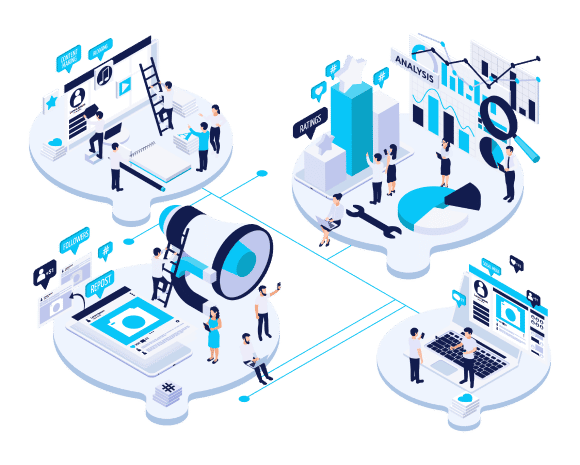Transforming Business Model for Top eCommerce Brands
Through the structured and comprehensive changes to people, processes, and technology.

Why do eCommerce Brands Need
Business Model Transformation?
There comes the point in a business life cycle when the business model changes become necessary for the business. The drivers could be competitive forces. Or changes in consumer behavior. Regardless of the reason, the business model may need to be changed substantially. And these changes can’t be done unless the transformation is comprehensive, considering all perspectives, people, processes, and technology.
Stagnant Growth
Stagnant growth is a major factor in why businesses might need to make transformative changes to their business model. The stagnant growth could be due to a combination of factors, such as outdated business models or systems that may be posing growth constraints.
Increased Customer Expectations
Based on the changes in the industry, consumer preferences might change because of their delivery or product bundle experience expectations. And they drive brands to make substantial changes to their business model to avoid losing market share.
Lack of Control on Revenue
Traditional B2C and B2B businesses are often too dependent on their channel partners for revenue. And because of this, they might not get enough visibility into reasons for revenue share loss. Brands need to make transformational changes to their channel strategy or business to get back control of revenue share.
Macroeconomic Trends
Macroeconomic trends such as geopolitical tension or inflation may drive prices or supply chain constraints, and that might have an impact on margins. And these margin constraints require brands to reconsider their strategy and make transformational changes to their business model.
Changing Competitive Landscape
The competitors might be ahead with their technology maturity, and because of that, they might be able to offer superior customer experience or cheaper prices, which forces brands to review their business model. And make transformative changes to retain their market. Or gain new market share.
Untapped Opportunities
New opportunities may arise because of the changes in business models or practices such as DTC, BOPIS, or ROPIS. And in order to take advantage of these opportunities, brands make transformational changes to their business model.
Want to learn more about why independent consultants have a higher success rate with business model transformation?
Our Case Studies for
E-commerce Business Model Transformation

ECommerce Supply Chain Transformation With ERP Selection
Download the eCommerce Supply Chain transformation case study and learn how LockNLube transformed its inventory and supply chain challenges by consolidating over 20 systems. As well as by creating business, process, information, and system architecture as they prepare for the next phase of their growth.

Omnichannel eCommerce Customer Experience Transformation
Download the omnichannel eCommerce customer experience case study and learn how fashion retailer AKIRA built a digital roadmap and managed stakeholder expectations to transform its processes and systems to explore newer business models such as buy-online-pickup-in-store and curbside pickup.

ERP Optimization and Integration Architecture Development
Download the ERP optimization and integration architecture development case study and learn how Work Sharp fixed their broken ERP implementation that caused customer service issues and improved Supply Chain planning.
Our Methodology
for Digital Commerce Business Model Transformation
The process starts with the assessment of your current business model and understanding potential causes for revenue growth issues. Once identified, a comprehensive plan is developed, with any changes that might be required for people, processes, and technology to enable the new business model.

1 Assessment
Through primary and secondary research, this assessment digs into each of your datasets, transactions, and processes to develop as-is and to-be states for business model transformation (with several options for to-be states along with their pros and cons).
3Business Model Transformation Technical Analysis
This step performs the technical analysis given the existing or new technologies required in the architecture. As well as considering the state of existing master data. This step also helps in building the implementation plan with the budget and the timeline required for implementation.
5Adoption and Optimization
This phase measures whether the new changes to the business model are being adopted and meeting KPIs as set in the original vision. And if not, it makes further changes to the data, processes, or systems required to calibrate the KPIs and business model further until the new business model produces the intended results.
2Business Model Transformation Option Detailed Discovery
Once the team agrees with the desired option for the to-be state, a detailed analysis is performed to remove any financial risks with the option. As well as to assess the financial feasibility of the plan.
4Implementation
This step goes through a series of sprints to make changes to the people, process, and technology as determined in the planning stage. The plan and this phase may need to be tweaked based on the outcome of each sprint. Each phase may contain testing and training workshops that might run in parallel with the implementation phase.
Ready to learn how we can help With eCommerce Business Model Transformation?
Our Other
eCommerce Services
ElevatIQ eCommerce services include digital strategy roadmap, channel analysis, product profitability analysis, customer journey mapping, UX and conversion issues, eCommerce platform optimization, system integration, eCommerce platform selection, re-platforming, and contract negotiations.
Digital Strategy and Planning
This service helps in defining customer journeys to improve the effectiveness of your sales and marketing channels or you need a comprehensive strategy to penetrate a target market.
Headless Commerce Strategy and Architecture
This service helps eCommerce brands with headless architecture enablement, whether you need a custom headless solution or integration with monolithic platforms such as SAP Hybris and Salesforce Commerce Cloud. Or utilizing a newer breed of headless platforms such as commercetools, Spryker, or VTEX.
E-commerce Solution Architecture
This service helps in setting the right foundation for your architecture, whether your architecture might contain just one platform or several, including PIM, DAM, DXP, and CMS. ElevatIQ can help define the architecture you need to enable customer experience.


